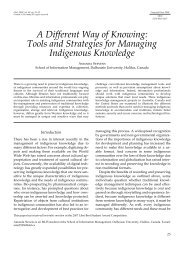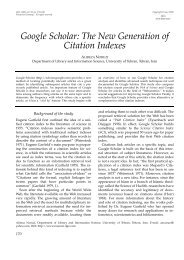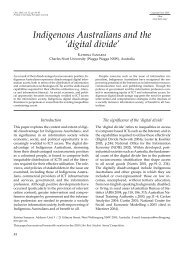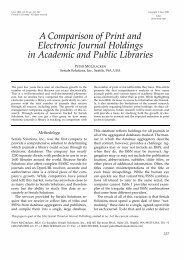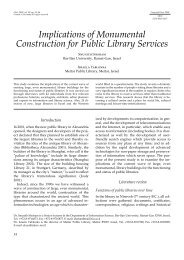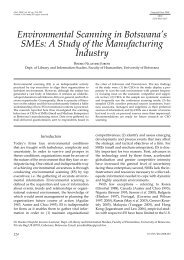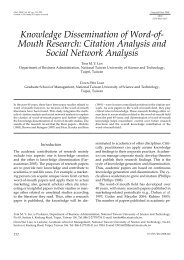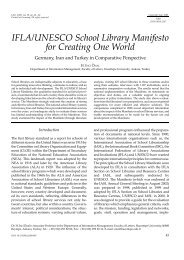The Political Economy of Public Library Development in post ... - Libri
The Political Economy of Public Library Development in post ... - Libri
The Political Economy of Public Library Development in post ... - Libri
Create successful ePaper yourself
Turn your PDF publications into a flip-book with our unique Google optimized e-Paper software.
Liangzhi Yu & Jianye Xueducational needs <strong>of</strong> <strong>in</strong>dividuals; and the lowertiers (libraries at county level and below) serv<strong>in</strong>gma<strong>in</strong>ly the recreational and educational needs <strong>of</strong>local residents. <strong>The</strong> theoretical guidance for thesystem’s development was allegedly derived fromMarxist theories which assert that the cultural <strong>in</strong>stitutionas part <strong>of</strong> the superstructure is subord<strong>in</strong>ateto the economic base.In 1978, Ch<strong>in</strong>a <strong>in</strong>augurated a program <strong>of</strong> economicreform. Dur<strong>in</strong>g the subsequent two and halfdecades, this reform brought about sweep<strong>in</strong>g effectson nearly all aspects <strong>of</strong> Ch<strong>in</strong>ese society. <strong>The</strong>public library system consequently underwentdramatic change as the country unfolded one reformstrategy after another, and as other public <strong>in</strong>stitutionsundertook sectoral reforms to keep pacewith the political and economic changes.<strong>The</strong> transformation <strong>of</strong> the Ch<strong>in</strong>ese health careand education sectors has been fairly extensivelyexplored and reported <strong>in</strong> English (Blumenthal andHsiao 2005; Hsiao 1995; Law 2002; Mahmoudi 2006;Mok 2000; Rong and Shi 2001; Venter 2004; WangChengzhi 2002; Wang, Yip, Zhang, Wang and Hsiao2005; Wong and Lee 2001). Few studies, however,have <strong>of</strong>fered a thorough political economyanalysis <strong>of</strong> public libraries. An early study by T<strong>in</strong>g(1983) was an exception, but at that time the newpolitical economy had scarcely emerged. Consequently,current understand<strong>in</strong>g <strong>of</strong> Ch<strong>in</strong>ese publiclibraries <strong>in</strong> the world’s literature is <strong>in</strong>evitably dilutedby the lack <strong>of</strong> contextual awareness; it is alsovery much overshadowed by the pre-1978 picture<strong>of</strong> a fairly uniform service provision across thecountry. L<strong>in</strong> (1998) and Liu (1996), for example,both spoke <strong>of</strong> the <strong>post</strong>-1978 public library as anactive player <strong>in</strong> national economic development;neither, however, gave adequate analysis <strong>of</strong> theadverse effect that economic development had onpublic libraries. Likewise, Gong and Gorman(2000) talked about major types <strong>of</strong> public library activityand function without not<strong>in</strong>g the <strong>in</strong>creas<strong>in</strong>glymarked trend <strong>of</strong> geographical diversities. Such<strong>in</strong>complete understand<strong>in</strong>g pervades even the librarianshipliterature <strong>in</strong> Ch<strong>in</strong>ese (Feng 1996;Huang 2000; Kang 1997; Li 2004; Yang 2003; Yangand Wang 2005, Wang Xiangnan 2001; Wang Xueguang2001; Zou et al. 1999a, 1999b).This paper attempts to provide an analysis <strong>of</strong>the contemporary Ch<strong>in</strong>ese public library by situat<strong>in</strong>git <strong>in</strong> the <strong>post</strong>-1978 political and economiccontext. It is hoped that such a discussion will notonly improve the knowledge about current Ch<strong>in</strong>esepublic libraries <strong>of</strong> comparative librarianshipstudents, but also provide relevant lessons forlibrary pr<strong>of</strong>essionals <strong>in</strong> other transform<strong>in</strong>g economieslike Ch<strong>in</strong>a.Data sources<strong>The</strong> analysis presented <strong>in</strong> this paper is based primarilyon two strands <strong>of</strong> data source. <strong>The</strong> firststrand consists <strong>of</strong> published statistics (mid-1980sto present), pr<strong>of</strong>essional literature and publishedspeeches <strong>of</strong> government <strong>of</strong>ficials relat<strong>in</strong>g to publiclibraries. <strong>The</strong> second is empirical data collectedthrough a series <strong>of</strong> site visits to twelve localities<strong>of</strong> four prov<strong>in</strong>ces (<strong>in</strong>clud<strong>in</strong>g one municipality andone autonomous region), dur<strong>in</strong>g which, library directorsand local <strong>of</strong>ficials were <strong>in</strong>terviewed. <strong>The</strong>four prov<strong>in</strong>ces (one <strong>in</strong> the East, one <strong>in</strong> the North,and two <strong>in</strong> the Northwest) were selected to reflectthe varied development levels across Ch<strong>in</strong>a.With<strong>in</strong> each prov<strong>in</strong>ce, three different localities (respectivelyunder the jurisdiction <strong>of</strong> the prov<strong>in</strong>cialgovernment, the city government and county government)were visited. <strong>The</strong>matic threads <strong>of</strong> howeconomic reform mandated the change <strong>of</strong> publiclibraries and how public libraries responded toeconomic reform were pulled from both <strong>of</strong> theabove sources to <strong>in</strong>form the discussion <strong>in</strong> thispaper.Data collection and the discussion focused deliberatelyon the period between 1978 and 2001.<strong>The</strong> year 2002 was made special by the conven<strong>in</strong>g<strong>of</strong> the 16 th National Congress <strong>of</strong> the Ch<strong>in</strong>ese CommunistParty and the transition <strong>of</strong> the party leadership,which was followed by the formation <strong>of</strong>the new government leadership <strong>in</strong> 2003. Whetherthis transition formed a watershed <strong>in</strong> the politicaland economic reform <strong>of</strong> Ch<strong>in</strong>a is open to dispute,but the past few years have seen the new leadershiptake strategic directions that were dist<strong>in</strong>ctlydifferent from those <strong>of</strong> the preced<strong>in</strong>g decades.Hav<strong>in</strong>g laid out the strategic target <strong>of</strong> “build<strong>in</strong>gup well-<strong>of</strong>f society <strong>in</strong> an all-round way” at the 16 thNational Party Congress <strong>in</strong> 2002, the CPC pledgedto build up a harmonious society <strong>of</strong> socialism atthe 4 th Plenum <strong>of</strong> the 16 th Party Congress CentralCommittee <strong>in</strong> 2004, and proposed to build “a newsocialist countryside” at the 5 th Plenum <strong>of</strong> the 16 thParty Congress Central Committee <strong>in</strong> 2005. Howthese strategic directions (and the result<strong>in</strong>g politi-118
<strong>The</strong> <strong>Political</strong> <strong>Economy</strong> <strong>of</strong> <strong>Public</strong> <strong>Library</strong> <strong>Development</strong> <strong>in</strong> <strong>post</strong>-1978 People’s Republic <strong>of</strong> Ch<strong>in</strong>acal economy) will impact public library developmentis yet to be seen.<strong>The</strong> Institutional Framework for <strong>Public</strong><strong>Library</strong> <strong>Development</strong>As mentioned <strong>in</strong> the <strong>in</strong>troductory section, the currentCh<strong>in</strong>ese public library system consists <strong>of</strong> multipletiers, rang<strong>in</strong>g from prov<strong>in</strong>cial libraries downto township libraries.M<strong>in</strong>istry <strong>of</strong> Culture<strong>The</strong> M<strong>in</strong>istry <strong>of</strong> Culture (MOC), a state governmentagency under the jurisdiction <strong>of</strong> the StateCouncil, oversees the development <strong>of</strong> this systemas a whole. Through its Mass Culture and <strong>Library</strong>division and <strong>in</strong> conjunction with the local government’scultural department, the MOC drawsup national public library development policiesand plans, provides guidance for library practices,advocates/coord<strong>in</strong>ates national cooperativeschemes and promotes standardization and modernization<strong>of</strong> library operation.In the policy-mak<strong>in</strong>g doma<strong>in</strong>, the MOC haspromulgated a number <strong>of</strong> national policies thatare relevant to public library service provisions<strong>in</strong>ce 1978. <strong>The</strong>se <strong>in</strong>clude, among others, the 1982Regulations for Prov<strong>in</strong>cial (Autonomic Region, Municipal)<strong>Library</strong> Work, the 1987 Provisional Methods<strong>of</strong> Implement<strong>in</strong>g Fee-based Services and Bus<strong>in</strong>ess Activities<strong>in</strong> Cultural Institutions, the 1991 Report on aNumber <strong>of</strong> Economic Policies for Cultural Institutionsand the 2002 M<strong>in</strong>istry <strong>of</strong> Culture Notification onEnrich<strong>in</strong>g Cultural Activities at the Grass-root Level.Of these, the 1982 Regulations for Prov<strong>in</strong>cial (AutonomicRegion, Municipal) <strong>Library</strong> Work providedthe general policy framework for prov<strong>in</strong>cial andlarge city libraries dur<strong>in</strong>g the 1980s; the ProvisionalMethods <strong>of</strong> Implement<strong>in</strong>g Fee-based Services and Bus<strong>in</strong>essActivities <strong>in</strong> Cultural Institutions authorizedcultural organizations like public libraries to developfee-based services; the Report on a Number<strong>of</strong> Economic Policies for Cultural Institutions urgedlocal governments to ensure funds for cultural developmentand reiterated the legitimacy <strong>of</strong> feebasedservices. Meanwhile, the MOC has alsodrawn up a series <strong>of</strong> five-year plans for nationalcultural development. In its Outl<strong>in</strong>e <strong>of</strong> the 10 th FiveYear Plan for <strong>Public</strong> Sector Cultural <strong>Development</strong>,for <strong>in</strong>stance, the MOC laid out the target to have80% <strong>of</strong> libraries at and above the prefecture level,and 30% <strong>of</strong> libraries at the county level connectedto the Internet. <strong>The</strong>se policies and developmentplans are illustrative <strong>of</strong> the directive role <strong>of</strong> theMOC <strong>in</strong> public library development.In addition to this directive role, the M<strong>in</strong>istry<strong>of</strong> Culture also plays a leadership role <strong>in</strong> nationalschemes <strong>of</strong> service provision. In recent years, forexample, the MOC has led a number <strong>of</strong> nationwidelibrary <strong>in</strong>itiatives, such as the “<strong>Public</strong> <strong>Library</strong>Performance Measurement Initiative” (a libraryassessment exercise on a quadrennial basis),the “Digital <strong>Library</strong> Initiative <strong>of</strong> Ch<strong>in</strong>a” (a projectled by the National <strong>Library</strong> <strong>of</strong> Ch<strong>in</strong>a to build upthe world’s largest digital <strong>in</strong>formation repository<strong>of</strong> Ch<strong>in</strong>ese language materials), the “KnowledgeInitiative” (a read<strong>in</strong>g promotion scheme across thecountry) and the “Shared National Cultural Resources”(a national scheme to build up a distributedand shared digital cultural resource).Local GovernmentNotwithstand<strong>in</strong>g the strategic role <strong>of</strong> the MOC <strong>in</strong>library affairs, Ch<strong>in</strong>ese public library development<strong>in</strong> the <strong>post</strong>-1978 era has been essentially a localbus<strong>in</strong>ess. Individual libraries at each tier areprimarily f<strong>in</strong>anced and adm<strong>in</strong>istered by the correspond<strong>in</strong>gtier <strong>of</strong> local government. With theDepartment (Bureau) <strong>of</strong> Culture as the primaryagency for archives, museums, libraries and othercultural <strong>in</strong>stitutions, the local government plays anumber <strong>of</strong> dist<strong>in</strong>ct roles <strong>in</strong> public library development.Firstly, it provides the dom<strong>in</strong>ant segmentfor both the capital expenditure and the operat<strong>in</strong>gexpenditure <strong>of</strong> libraries, thereby function<strong>in</strong>g as theprovider <strong>of</strong> local public library services. Secondly,through its department <strong>of</strong> culture, the local governmentalso takes part <strong>in</strong> the adm<strong>in</strong>istration andmanagement <strong>of</strong> local public libraries. This role enableslocal governments to be <strong>in</strong>volved <strong>in</strong> a widerange <strong>of</strong> pr<strong>of</strong>essional practices, such as personnelmanagement, cont<strong>in</strong>u<strong>in</strong>g pr<strong>of</strong>essional education,performance assessment, fund rais<strong>in</strong>g and publicrelations. Thirdly, the local government als<strong>of</strong>unctions as the govern<strong>in</strong>g authority for libraries,responsible for draw<strong>in</strong>g up local library developmentpolicies and plans, and for mak<strong>in</strong>g major decisions.Dur<strong>in</strong>g the latter half <strong>of</strong> the 1990s, whenthe 1982 Regulations for Prov<strong>in</strong>cial (Autonomic Region,Municipal) <strong>Library</strong> Work became <strong>in</strong>creas<strong>in</strong>gly119
Liangzhi Yu & Jianye Xuobsolete <strong>in</strong> the new political and economic context,a number <strong>of</strong> prov<strong>in</strong>cial governments issued regionalpublic library regulations. <strong>The</strong> Culture Bureau<strong>of</strong> the Shanghai Municipal Government issuedthe Measures for <strong>Public</strong> <strong>Library</strong> Management<strong>in</strong> Shanghai <strong>in</strong> 1996; the Shenzhen Government issuedthe <strong>Public</strong> <strong>Library</strong> Regulations <strong>of</strong> Shenzhen SpecialEconomic Zone <strong>in</strong> 1997; the Beij<strong>in</strong>g MunicipalGovernment issued the <strong>Library</strong> Regulations <strong>of</strong> Beij<strong>in</strong>g<strong>in</strong> 2002. Like the national regulation <strong>of</strong> 1982,these regional regulations also cover areas likelibrary expenditure, material acquisition, staff<strong>in</strong>gand open<strong>in</strong>g hours, etc.<strong>The</strong> Communist Party <strong>of</strong> Ch<strong>in</strong>aApart from the MOC and local governments, theCPC (Communist Party <strong>of</strong> Ch<strong>in</strong>a) and the People’sCongress at national and local levels alsoexert great <strong>in</strong>fluence on public library development(see Figure 1). <strong>The</strong> CPC sets out the nationalpolicies and frameworks that control the nation’ssocial and economic development. Through theCentral Propaganda Department and other partyorganizations, the CPC also issues decisions, <strong>in</strong>structionsor op<strong>in</strong>ions that have a direct policy effectfor cultural <strong>in</strong>stitutions. In 1980, for example,the Secretariat <strong>of</strong> the CPC Central Committee issuedthe Outl<strong>in</strong>e for <strong>Library</strong> Work, and <strong>in</strong> 1987, theCentral Propaganda Department, together withthree other governmental organizations, issued theReport on Improv<strong>in</strong>g and Strengthen<strong>in</strong>g <strong>Library</strong> Work.Both documents played an <strong>in</strong>strumental role <strong>in</strong>restor<strong>in</strong>g and strengthen<strong>in</strong>g library work <strong>in</strong> theaftermath <strong>of</strong> the Cultural Revolution. Dur<strong>in</strong>g thepast decade, the 6 th Plenum <strong>of</strong> the 14 th Party CongressCentral Committee held <strong>in</strong> 1996 adopted theResolution <strong>of</strong> the CPC Central Committee on a Number<strong>of</strong> Issues Related to the Enhancement <strong>of</strong> Socialist SpiritualConstruction, which urged local governmentsto pay greater attention to the strategic role <strong>of</strong> culture<strong>in</strong> socio-economic development; the 15 th CPCCongress held <strong>in</strong> 1997 proposed to build “socialistculture with Ch<strong>in</strong>ese characteristics”, whichaimed to br<strong>in</strong>g the spiritual standard <strong>of</strong> Ch<strong>in</strong>esepeople to the level <strong>of</strong> great ideals, high morality,and great sense <strong>of</strong> culture and discipl<strong>in</strong>e; the16 th CPC Congress held <strong>in</strong> 2002 adopted the ThreeRepresents theory, with one <strong>of</strong> its elements deal<strong>in</strong>gspecially with the cultural dimension <strong>of</strong> the partyl<strong>in</strong>e, stat<strong>in</strong>g that the CPC represents the progressivedirection <strong>of</strong> advanced Ch<strong>in</strong>ese culture. It isparty resolutions, decisions and theories such asthese that have guided the formation <strong>of</strong> governmentcultural policies at both the national andlocal levels.In addition to policy-mak<strong>in</strong>g, the CPC can alsoexert <strong>in</strong>fluence on public libraries through its authority<strong>in</strong> personnel appo<strong>in</strong>tment. In accordancewith regulations govern<strong>in</strong>g the Ch<strong>in</strong>ese cadre system,key personnel <strong>in</strong> public libraries, as <strong>in</strong> otherpublic <strong>in</strong>stitutes, are either appo<strong>in</strong>ted or approvedby the party organization at correspond<strong>in</strong>g levels.For example, the appo<strong>in</strong>tment <strong>of</strong> key personnel<strong>in</strong> prov<strong>in</strong>cial libraries is controlled either by theOrganization Department <strong>of</strong> the Prov<strong>in</strong>cial PartyCommittee or the Party Committee with<strong>in</strong> thelocal Department <strong>of</strong> Culture. Personnel thus appo<strong>in</strong>tedcan <strong>of</strong>ten play an important role <strong>in</strong> ensur<strong>in</strong>gthat libraries develop <strong>in</strong> the ideological andfunctional directions <strong>in</strong>tended by the party andthe government.<strong>The</strong> People’s congresses are the lawmak<strong>in</strong>g bodyenshr<strong>in</strong>ed by the Constitution. Of them, the NationalPeople’s Congress (NPC) is the highest andcomprises representatives elected from the nation’sprov<strong>in</strong>ces, autonomous regions, directly adm<strong>in</strong>isteredmunicipalities and the army. NPC has thepower to make national laws. When the plenarysession is <strong>in</strong> recess, the NPC Stand<strong>in</strong>g Committeehas the power to enact, amend and <strong>in</strong>terpret laws.Regional and local congresses are the next level <strong>of</strong>legislature. Prov<strong>in</strong>cial level congresses can maketheir own regional laws and send them to the NPCStand<strong>in</strong>g Committee for the record, whereas localcongresses can make local laws, but need approvalfrom their respective regional congresses beforepromulgation. <strong>The</strong> NPC can also delegate to thegovernment a certa<strong>in</strong> degree <strong>of</strong> legislative power.<strong>The</strong>refore the State Council and m<strong>in</strong>istries underits aegis (<strong>in</strong>clud<strong>in</strong>g the MOC) all have designatedlegislative power to make regulations and ruleswith<strong>in</strong> their own adm<strong>in</strong>istrative areas (Law 2002,583). At the moment, a national public library actdoes not yet exist, but there are already a number<strong>of</strong> prov<strong>in</strong>cial regulations which provide the policybasis for public library development <strong>in</strong> regions.At the local level, the People’s Congress is alsoenshr<strong>in</strong>ed with the power to approve local government’sbudgetary plans and can thus have determ<strong>in</strong>ant<strong>in</strong>fluence on the outcome <strong>of</strong> proposedlibrary projects. Dur<strong>in</strong>g the past two decades,120
<strong>The</strong> <strong>Political</strong> <strong>Economy</strong> <strong>of</strong> <strong>Public</strong> <strong>Library</strong> <strong>Development</strong> <strong>in</strong> <strong>post</strong>-1978 People’s Republic <strong>of</strong> Ch<strong>in</strong>aFigure 1: <strong>The</strong> <strong>in</strong>stitutional framework for public library development <strong>in</strong> Ch<strong>in</strong>amany People’s Congresses endorsed the construction<strong>of</strong> new libraries <strong>in</strong> their constituencies. InSuzhou city <strong>of</strong> Jiangsu Prov<strong>in</strong>ce, for example, aproposal for the city’s new library was submittedto the local People’s Congress <strong>in</strong> 1997-1998, andwas approved unanimously at the first meet<strong>in</strong>gdiscuss<strong>in</strong>g it. Accord<strong>in</strong>g to the local <strong>of</strong>ficials <strong>in</strong>terviewedby this study, no other social utilities orbus<strong>in</strong>ess outlets had such unanimous support.<strong>The</strong> National <strong>Political</strong> <strong>Economy</strong> for <strong>Public</strong><strong>Library</strong> <strong>Development</strong> <strong>in</strong> Post-1978 Era<strong>The</strong> history <strong>of</strong> the People’s Republic <strong>of</strong> Ch<strong>in</strong>a isdivided <strong>in</strong>to two dist<strong>in</strong>ct eras <strong>in</strong> political and economicterms. <strong>The</strong> first era was from 1949 to 1978.It was characterized by a state-planned economy,radical socialism, economic self-sufficiency and afair degree <strong>of</strong> egalitarianism. It is also an era <strong>in</strong>which stable economic development was periodically<strong>in</strong>terrupted by political movements, thelongest and the most destructive <strong>of</strong> which was theCultural Revolution (1966–1976). <strong>The</strong> second erawas from 1978 to the present. This is an era characterizedby determ<strong>in</strong>ed economic reform, steadymovement from a planned economy to a marketeconomy, rapid economic growth and greater division<strong>of</strong> society.It is the second era that provides the major contextfor current Ch<strong>in</strong>ese public library development.<strong>The</strong> era was heralded by the 3 rd Plenum <strong>of</strong>the 11 th Party Congress Central Committee <strong>in</strong> December1978, which ruled that the long held emphasis<strong>of</strong> the CPC on political and ideologicalcampaigns was to be abandoned; and future work<strong>of</strong> the party was to be centred on economic development.<strong>The</strong> decision to focus on economicdevelopment was <strong>of</strong>ficially <strong>in</strong>terpreted as a shift<strong>of</strong> the party’s central concern from political andideological campaigns to economic construction,but <strong>in</strong> reality, it was also implemented to prioritiseeconomic development over social development.<strong>The</strong>se resolutions <strong>in</strong>stitutionalised a break<strong>in</strong>gaway from the focus <strong>of</strong> the first era and paved theway for economic reform.Globalization<strong>The</strong> subsequent economic reforms centred on threema<strong>in</strong> themes: globalisation, marketization and decentralization(Wei 2002, 114). Globalisation wasa process <strong>in</strong> which Ch<strong>in</strong>a became <strong>in</strong>creas<strong>in</strong>gly121
Liangzhi Yu & Jianye Xu<strong>in</strong>volved <strong>in</strong> the world economy through her opendoorpolicies, culm<strong>in</strong>at<strong>in</strong>g <strong>in</strong> her entrance <strong>in</strong>to theWTO <strong>in</strong> 2001. In 1979, shortly after the 3 rd Plenum<strong>of</strong> the 11 th Party Congress Central Committee, alegislative framework to encourage foreign <strong>in</strong>vestment,namely the Jo<strong>in</strong>t Venture Law, was enactedand a decision to establish a production base forexport <strong>in</strong> Shenzen was made. In 1980, the ShenzhenProduction Base for Export was changed tothe Shenzhen Special Economic Zone, along withthe establishment <strong>of</strong> Zhuhai, Shantou and Xiamenspecial economic zones (SEZs). A new economybased on a great <strong>in</strong>take <strong>of</strong> foreign <strong>in</strong>vestment anda large degree <strong>of</strong> market mechanism was thus setrunn<strong>in</strong>g with<strong>in</strong> these SEZs. Beg<strong>in</strong>n<strong>in</strong>g <strong>in</strong> 1984,many more coastal and <strong>in</strong>land cities were openedup for foreign <strong>in</strong>vestment and trade, and <strong>in</strong> themeantime, new policies for attract<strong>in</strong>g foreign capitalwere <strong>in</strong>stigated. <strong>The</strong>se policies soon transformedthe country <strong>in</strong>to one <strong>of</strong> the largest recipientsfor foreign <strong>in</strong>vestment <strong>in</strong> the world. <strong>The</strong><strong>of</strong>ficial admission <strong>of</strong> Ch<strong>in</strong>a <strong>in</strong>to the WTO <strong>in</strong> 2001heralded a new era <strong>of</strong> her participation <strong>in</strong> theglobal economy. S<strong>in</strong>ce then, Ch<strong>in</strong>a has furtheropened many <strong>of</strong> her previously withheld sectorsto foreign capital, <strong>in</strong>clud<strong>in</strong>g, to the great concern<strong>of</strong> library and <strong>in</strong>formation pr<strong>of</strong>essionals: the telecommunicationsector; the wholesale market <strong>of</strong>books, newspapers and periodicals; and the advertis<strong>in</strong>gmarket.MarketizationMarketization <strong>in</strong> the aforementioned triple transitionwas a process <strong>in</strong> which the state-plannedeconomy was gradually transformed to a marketbasedeconomy. In the early 1980s, the marketmechanism was first <strong>in</strong>troduced to the pric<strong>in</strong>gsystem. A two-track price system was created toreplace the previously state controlled pric<strong>in</strong>g systemwhere all goods were fixed with prices fromthe centre. In the mean time, the ownership structureunderwent gradual reform to allow non-public<strong>in</strong>vestment. <strong>The</strong> course <strong>of</strong> marketization wasdramatically furthered <strong>in</strong> 1987 when the “theory<strong>of</strong> the early stage <strong>of</strong> socialism” was adopted at the13 th Party Congress, and <strong>in</strong> 1992 when the “theory<strong>of</strong> the market socialism” was adopted at the14 th Party Congress, and aga<strong>in</strong> <strong>in</strong> 1997 when theprivate economy was upgraded from a complementarypart <strong>of</strong> the national economy to thestatus <strong>of</strong> an <strong>in</strong>tegrated part. As a result <strong>of</strong> theabove process <strong>of</strong> reform, the number <strong>of</strong> privateenterprises and small bus<strong>in</strong>esses <strong>in</strong>creased rapidly.By the end <strong>of</strong> the 1990s, there were alreadyover 1.76 million private enterprises <strong>in</strong> Ch<strong>in</strong>a,over 48 thousand (or 2.7%) <strong>of</strong> which were <strong>in</strong>formationconsultant companies (Trade and Foreign<strong>Economy</strong> Division <strong>of</strong> National Bureau <strong>of</strong> Statistics<strong>of</strong> Ch<strong>in</strong>a 2002). Incomplete statistics provided respectivelyby the Statistical Yearbook <strong>of</strong> Ch<strong>in</strong>eseCulture and Relics (2001) and the M<strong>in</strong>istry <strong>of</strong> Culture(Wang Xuan 2002) showed that, <strong>in</strong> 2000, therewere nearly 30,000 audio-video rental outlets <strong>in</strong>regions exclud<strong>in</strong>g Beij<strong>in</strong>g, Shanghai and Tianj<strong>in</strong>;and <strong>in</strong> 2002, there were nearly 120,000 registeredInternet Bars across the country.Various forms and degrees <strong>of</strong> marketizationhave also been extended to the educational and culturalsectors s<strong>in</strong>ce the mid-1980s. In the educationsector, a series <strong>of</strong> CPC resolutions and M<strong>in</strong>istry <strong>of</strong>Education policies were <strong>in</strong>stigated to attract nongovernmentfunds. <strong>The</strong>se <strong>in</strong>clude the 1985 CPCdocument Decision <strong>of</strong> the Central Committee <strong>of</strong> CommunistParty <strong>of</strong> Ch<strong>in</strong>a on the Reform <strong>of</strong> the EducationalStructure and <strong>The</strong> Outl<strong>in</strong>e <strong>of</strong> Education Reform and<strong>Development</strong> <strong>in</strong> Ch<strong>in</strong>a (promulgated by the CentralCommittee <strong>of</strong> the CPC and the State Council). Inthe cultural sector where the public library is located,there were even more dramatic reforms to<strong>in</strong>troduce market forces. <strong>The</strong>se <strong>in</strong>cluded the transformation<strong>of</strong> a large section <strong>of</strong> the sector frompublicly funded <strong>in</strong>stitutes to self-susta<strong>in</strong><strong>in</strong>g enterprises,the <strong>in</strong>troduction <strong>of</strong> private capital and thelegitimat<strong>in</strong>g <strong>of</strong> <strong>in</strong>come generation <strong>in</strong> previouslypurely publicly funded organizations such as libraries.Instrumental to these changes were suchgovernment regulations as the 1987 ProvisionalMethod <strong>of</strong> Implement<strong>in</strong>g Fee-based Services and Bus<strong>in</strong>essActivities <strong>in</strong> Cultural Institutions, which authorizedcharges for services <strong>in</strong> organizations likelibraries; the 1991 Report on a Number <strong>of</strong> EconomicPolicies for Cultural Organizations, which furthercalled for publicly funded cultural organizationsto generate <strong>in</strong>come so as to reduce their relianceon the government; the 1994 Decisions on Cont<strong>in</strong>uedPreferential Fiscal Policies for Cultural PropagandaOrganizations, which stipulated that culturalpropaganda organizations should speed up theirreform to adjust themselves to the socialist marketsystem.122
DecentralizationDecentralization <strong>of</strong> the aforementioned triple transitionwas a process <strong>in</strong> which the state graduallyloosened its central control through devolution <strong>of</strong>adm<strong>in</strong>istrative and economic power to local governments.Details <strong>of</strong> this process and its impacton the local political economy will be elaborated<strong>in</strong> the next section; it suffices here to note that theprocess led to a dramatic shift <strong>of</strong> the central-localrelationship, with a great degree <strong>of</strong> power and responsibilitybe<strong>in</strong>g transferred from the centre tolocal governments. This brought public libraryservices, together with education, health care, socialsecurity and other public sector services, out<strong>of</strong> central aegis and <strong>in</strong>to local control. Under the<strong>in</strong>fluence <strong>of</strong> local political economies, the Ch<strong>in</strong>esepublic library system began to show less uniformityand more local colours.<strong>The</strong> Local <strong>Political</strong> <strong>Economy</strong> for <strong>Public</strong><strong>Library</strong> <strong>Development</strong> <strong>in</strong> Post-1978 EraPrior to 1978, the Ch<strong>in</strong>ese local economy constitutedpart <strong>of</strong> the national planned economy tightlycontrolled by the central government. Under thissystem, virtually every aspect <strong>of</strong> the country’ssocial and economic development, from resourceallocation to price sett<strong>in</strong>g <strong>of</strong> commodities and topublic service provision, was determ<strong>in</strong>ed by centralgovernment plans. Local governments playedan agent role <strong>in</strong> organiz<strong>in</strong>g the implementation <strong>of</strong>these plans. To facilitate the central government’scontrol, a network <strong>of</strong> hierarchically organized <strong>in</strong>stitutionswas established which carried out centralplans <strong>in</strong> different fields through a “verticalsystem”. Long and Ng (2001, 217) likened this central-localrelationship to the relationship betweenfather and sons <strong>in</strong> a traditional family, wherethe father controlled all the family’s resourcesand shouldered the responsibilities for the livelihood<strong>of</strong> the whole family, whereas the sons implementedall the family’s rules and regulationsand worked hard for the property <strong>of</strong> the family.Devolution <strong>of</strong> power<strong>The</strong> <strong>Political</strong> <strong>Economy</strong> <strong>of</strong> <strong>Public</strong> <strong>Library</strong> <strong>Development</strong> <strong>in</strong> <strong>post</strong>-1978 People’s Republic <strong>of</strong> Ch<strong>in</strong>aStart<strong>in</strong>g from 1978, <strong>in</strong> an attempt to improve the efficiency<strong>of</strong> the economy and to <strong>of</strong>fer <strong>in</strong>centives forlocal participation <strong>in</strong> economic reform, the Centralgovernment began to delegate powers andresponsibilities to local governments. <strong>The</strong> devolution<strong>of</strong> power took place on many fronts <strong>of</strong> thecentral-local relationship, but was particularlynotable <strong>in</strong> adm<strong>in</strong>istration, <strong>in</strong>vestment and thefiscal system. In the area <strong>of</strong> adm<strong>in</strong>istration, forexample, local governments were empowered tomake broad regional economic regulations, to takecharge <strong>of</strong> some previously centrally controlled enterprisesand to approve <strong>in</strong>vestment projects. Localgovernments also became <strong>in</strong>dependent entitiesto make <strong>in</strong>vestments and establish new firms. Inthe area <strong>of</strong> fiscal authority, the 1985 fiscal reformestablished a system which allowed lower-levelgovernments to submit a fixed amount or a fixedproportion <strong>of</strong> their fiscal revenues to its superiorgovernment, while reta<strong>in</strong><strong>in</strong>g what rema<strong>in</strong>ed forthemselves. Under the new fiscal system, thecentral government’s control <strong>of</strong> state revenues<strong>in</strong>evitably decl<strong>in</strong>ed <strong>in</strong> favor <strong>of</strong> local government’sfiscal power. Dur<strong>in</strong>g the first half <strong>of</strong> the 1990s,local governments contributed only 60% <strong>of</strong> staterevenues and accounted for 70% <strong>of</strong> expenditure,<strong>in</strong> contrast with 85% <strong>of</strong> contribution and 46%<strong>of</strong> expenditure dur<strong>in</strong>g the first half <strong>of</strong> the 1970s(Yabuki and Harner 1999, 160). As more adm<strong>in</strong>istrativeand economic powers were delegated tolocal governments, the central government alsobegan to reduce its <strong>in</strong>volvement <strong>in</strong> f<strong>in</strong>anc<strong>in</strong>g publicservices. In education, for <strong>in</strong>stance, the centralgovernment not only shifted the responsibility forprimary and secondary education to local governments,but also reduced its f<strong>in</strong>ancial support for<strong>post</strong>-secondary education. In such waves <strong>of</strong> dualdelegation <strong>of</strong> powers and responsibilities, localautonomy steadily grew.Economic growthFor those who want to situate Ch<strong>in</strong>ese publiclibrary services <strong>in</strong> the context <strong>of</strong> the new localpolitical economy, it must be further noted thatas prov<strong>in</strong>ces and sub-prov<strong>in</strong>cial units assumedan autonomous economic role, the political <strong>in</strong>terests<strong>of</strong> local governments and their <strong>of</strong>ficialsbecame <strong>in</strong>creas<strong>in</strong>gly tied up with their economicperformance. Good economic performance wouldfirst <strong>of</strong> all give local governments enhanced barga<strong>in</strong><strong>in</strong>gpower when they negotiated with thecentre on local affairs. From the early days <strong>of</strong>economic reform, the devolution <strong>of</strong> power was123
Liangzhi Yu & Jianye Xunever evenly distributed across the country. <strong>The</strong>degree <strong>of</strong> autonomy granted to local governmentswas, at least <strong>in</strong> part, the result <strong>of</strong> central and localnegotiation. Dur<strong>in</strong>g such negotiation, three areas<strong>of</strong> local governments – economic performance,reliance on central subsidies and the degree <strong>of</strong> autonomyatta<strong>in</strong>ed, were almost always <strong>in</strong>terrelated(Hendrischke 1998). Prov<strong>in</strong>ces with stronger localeconomic stand<strong>in</strong>g were normally less dependenton central support and subsidies, and <strong>in</strong> return,they were <strong>of</strong>ten given greater power to controllocal affairs. Moreover, as this type <strong>of</strong> central-local<strong>in</strong>teraction developed, prov<strong>in</strong>ces with bettereconomic performance tended to enjoy greaterpolitical <strong>in</strong>fluence both with<strong>in</strong> their own regionand <strong>in</strong> the national arena. Secondly, economicperformance would also produce personal politicalga<strong>in</strong>s for local government <strong>of</strong>ficials. Prov<strong>in</strong>cialand sub-prov<strong>in</strong>cial leaders tended to have a highpolitical stake <strong>in</strong> the successful development <strong>of</strong>local economies. <strong>The</strong>y were likely to be promotedafter their region or localities had demonstrated asteady and fast economic growth. Tan (2002, 739)contends that Zhao Ziyang’s promotion to Premier<strong>in</strong> 1980 was the result <strong>of</strong> his economic success<strong>in</strong> Sichuan and the ascendance <strong>of</strong> Li Ruihuanto the stand<strong>in</strong>g Committee <strong>of</strong> the Politburo <strong>in</strong> 1990was due to his mayoral performance <strong>in</strong> develop<strong>in</strong>gTianj<strong>in</strong>’s economy.Dur<strong>in</strong>g the 1980s and 1990s, such economicand political <strong>in</strong>terests fueled local governments’pursuit for economic growth. Through mobilization<strong>of</strong> local resources and barga<strong>in</strong><strong>in</strong>g for centralsupport, many prov<strong>in</strong>ces started to pursue developmentstrategies that could maximize local economicgrowth. Jiangsu (a coastal prov<strong>in</strong>ce north toShanghai), for example, first pursued a developmentstrategy underp<strong>in</strong>ned by the strength <strong>of</strong>township and village enterprises (TVEs) and thenmoved on to a development strategy based ma<strong>in</strong>lyon science, technology and culture. Fujian (aprov<strong>in</strong>ce fac<strong>in</strong>g Ch<strong>in</strong>a’s Taiwan Island) adopted<strong>in</strong> 1984 a development strategy that focused ontransform<strong>in</strong>g its agriculture-based economy <strong>in</strong>toan <strong>in</strong>dustrial one, tak<strong>in</strong>g advantage <strong>of</strong> relativelyeasy access to overseas Ch<strong>in</strong>ese <strong>in</strong>vestors. Guizhou(a Southwestern prov<strong>in</strong>ce with many impoverishedareas), on the other hand, took up adevelopment strategy that capitalized on its rich<strong>in</strong>digenous culture. By and large, these strategieswere ma<strong>in</strong>ly economy driven, focus<strong>in</strong>g on the target<strong>of</strong> GDP growth and deploy<strong>in</strong>g whatever resourceswere deemed conducive to the growth.<strong>Public</strong> servicesUnder this context, it is not surpris<strong>in</strong>g that localgovernments would carefully weigh localresources and expenditures for their economicpotential, and prioritize local enterprises and<strong>in</strong>stitutions accord<strong>in</strong>g to their possible contributionto GDP. Areas that had foreseeable or at leastpromis<strong>in</strong>g economic returns were more likely toattract governments’ support, while most publicservices, <strong>in</strong>clud<strong>in</strong>g public libraries, dropped <strong>in</strong>priority on the local political agenda. Local governments’pragmatic, if not short-sighted viewtowards socio-economic development manifestednowhere so markedly as <strong>in</strong> the cultural sector.Here it became almost customary for cultural outletsthat had potential to boost the local tourismand that fit well <strong>in</strong>to the local cultural <strong>in</strong>dustry toenjoy greater political visibility than those withoutobvious economic value. This tendency was wellreflected <strong>in</strong> local governments’ generous <strong>in</strong>vestment<strong>in</strong> build<strong>in</strong>g <strong>in</strong>frastructure for local historicalsites and apply<strong>in</strong>g for world heritage membershipfor them. It is reported that, at the end <strong>of</strong> 1990s, <strong>in</strong>apply<strong>in</strong>g for the world heritage membership forLongmen Grottoes and Dujiang Weir, local governments<strong>in</strong>vested respectively 150 million and220 million [2] Yuan to demolish nearby build<strong>in</strong>gs(Huang 2002; Quan 2004). As some <strong>of</strong> the commentatorsobserved, <strong>in</strong> many places, the drivebeh<strong>in</strong>d such commitment had been ma<strong>in</strong>ly economic(Song 2001).As local governments directed their attentionand resources towards more pr<strong>of</strong>itable sectors ata time when the central subsidies dim<strong>in</strong>ished,public <strong>in</strong>stitutions <strong>in</strong> many regions began to facesevere f<strong>in</strong>ancial difficulties. Dur<strong>in</strong>g the 1980s and1990s, <strong>in</strong> an attempt to revive this decl<strong>in</strong><strong>in</strong>g sectorwhile mitigat<strong>in</strong>g local budgetary pressure, localgovernments, with endorsement from nationalregulations and policies, started to <strong>in</strong>troduce nongovernmentfunds and market mechanisms <strong>in</strong>topublic <strong>in</strong>stitutions. Sponsorship and private capitalwas sought <strong>in</strong> the education sector, user feeswere levied <strong>in</strong> the public health sector and <strong>in</strong>comegeneration was encouraged <strong>in</strong> the cultural sector.In education, for example, the proportion <strong>of</strong> nongovernmentfunds rose from 25.7% to 38.4% be-124
<strong>The</strong> <strong>Political</strong> <strong>Economy</strong> <strong>of</strong> <strong>Public</strong> <strong>Library</strong> <strong>Development</strong> <strong>in</strong> <strong>post</strong>-1978 People’s Republic <strong>of</strong> Ch<strong>in</strong>atween 1990 and 2000 (Zhou 2002). In public health,the health care system was almost entirely operated<strong>in</strong> l<strong>in</strong>e with market pr<strong>in</strong>ciples. In this process<strong>of</strong> transformation, both local governments and thepr<strong>of</strong>essions associated with public <strong>in</strong>stitutions becamevery much market m<strong>in</strong>ded.It is aga<strong>in</strong>st this backdrop <strong>of</strong> <strong>in</strong>creas<strong>in</strong>g local autonomy,grow<strong>in</strong>g emphasis on economic developmentand active embrac<strong>in</strong>g <strong>of</strong> market forces thatlocal governments began to take on a new outlooktowards public library development.<strong>Public</strong> <strong>Library</strong> <strong>Development</strong> <strong>in</strong> the Post-1978<strong>Political</strong> and Economic ContextBefore 1978, public library service, like educationand health care, was centrally provided by the statethrough a vertically managed system. <strong>The</strong> systemconsisted <strong>of</strong> prov<strong>in</strong>cial libraries, prefecture/municipallibraries, county libraries and townshiplibraries and was managed by the M<strong>in</strong>istry <strong>of</strong>Culture through its local agents, i.e., the culturedepartment <strong>of</strong> local governments.<strong>The</strong> 1978 reform shifted the responsibility forprovid<strong>in</strong>g public library services to local governments.With this shift, however, did not comeany clear national guidance as to how well localgovernments should provide these services. <strong>The</strong>1982 MOC Regulations for Prov<strong>in</strong>cial (Autonomic Region,Municipal) <strong>Library</strong> Work stipulated that “thenecessary funds for prov<strong>in</strong>cial libraries should beguaranteed”, but exactly what it meant by “necessary”was not clearly def<strong>in</strong>ed. <strong>The</strong> regulation alsohad a bylaw stat<strong>in</strong>g that the regulation was, <strong>in</strong>pr<strong>in</strong>ciple, also applicable to other types <strong>of</strong> largelibraries. <strong>The</strong>re were neither bylaws nor articlesperta<strong>in</strong><strong>in</strong>g to small and medium-sized libraries. Inthe absence <strong>of</strong> clear national guidance, the standard<strong>of</strong> “necessary fund<strong>in</strong>g” for prov<strong>in</strong>cial andlarge libraries and the level <strong>of</strong> support for smalland medium-sized libraries was left entirely to localgovernments. <strong>Public</strong> library development became,therefore, very much cont<strong>in</strong>gent on local economicperformance and the importance that localgovernments attached to library services <strong>in</strong> thescheme <strong>of</strong> general socio-economic development.Construction <strong>of</strong> new librariesAcross the country, economic growth, to a vary<strong>in</strong>gdegree, enabled the number <strong>of</strong> public librariesto grow and the work<strong>in</strong>g condition <strong>of</strong> libraries toimprove. In the <strong>in</strong>terval between 1980 and 1999,the number <strong>of</strong> public libraries at and above thecounty level <strong>in</strong>creased from 1732 to 2769; floorspace for public use <strong>in</strong>creased from 0.92 millionsquare meters to 5.06 million square meters (Xiao1999, 482–485; Xiao 2001, 354–357; Edit<strong>in</strong>g Board<strong>of</strong> Statistical Yearbook <strong>of</strong> Ch<strong>in</strong>ese Libraries 1997,480). As <strong>of</strong> the end <strong>of</strong> 2000, 20 out <strong>of</strong> 30 exist<strong>in</strong>gprov<strong>in</strong>cial libraries had moved <strong>in</strong>to new premises;another six were wait<strong>in</strong>g for the construction <strong>of</strong>new build<strong>in</strong>gs to be completed (Wu 2001, 9). Although<strong>of</strong>ficial statistics do not exist for rural libraries(township and village libraries), sporadicevidence suggests that this group <strong>of</strong> libraries expandedat an even greater rate. In Hunan Prov<strong>in</strong>ce,for example, the number <strong>of</strong> township and villagelibraries grew from 1800 <strong>in</strong> 1985 to 14000 <strong>in</strong> 1997(Zou et al. 1999b: 3); <strong>in</strong> Guangxi Autonomous Region,the correspond<strong>in</strong>g number <strong>in</strong>creased from 50<strong>in</strong> 1994 to 1342 <strong>in</strong> 2000 (Wang Xueguang 2001, 45).A number <strong>of</strong> factors may have encouraged localgovernments’ <strong>in</strong>put <strong>in</strong>to library construction.Rapid economic development enabled local governmentsto <strong>in</strong>vest more generously than before<strong>in</strong> urban construction. <strong>Public</strong> libraries, as one <strong>of</strong>the major cultural edifices <strong>of</strong> urban life and onewhich was rather neglected dur<strong>in</strong>g the CulturalRevolution, naturally came to the fore <strong>in</strong> urbanconstruction. <strong>The</strong> Sixth Five-Year Plan (1981–1985)proposed to elim<strong>in</strong>ate library-less counties. Thisfurther prompted library construction all over thecountry. And <strong>in</strong> 1994, the M<strong>in</strong>istry <strong>of</strong> Culturestarted a national public library assessment <strong>in</strong>itiative,<strong>in</strong> which libraries down to the county levelwere all assessed for their condition and services.Floor space and other <strong>in</strong>put measures were givennotable priority <strong>in</strong> the assessment with a view tourg<strong>in</strong>g local governments to improve library construction.S<strong>in</strong>ce 1994, there have been three rounds <strong>of</strong> assessment;each produced three grades <strong>of</strong> comparativelygood libraries. This fuelled the localgovernments’ <strong>in</strong>terest <strong>in</strong> library construction evenfurther. Want<strong>in</strong>g to have more graded libraries <strong>in</strong>the list, local governments made great efforts to<strong>in</strong>crease the floor space and facilities <strong>of</strong> their libraries.In Hunan Prov<strong>in</strong>ce, for example, the 1998assessment prompted local governments to provide10 million <strong>in</strong> ex-budgetary funds for libraries(amount<strong>in</strong>g to 41% <strong>of</strong> the budgetary library125
Liangzhi Yu & Jianye Xufund for the year 1999), all earmarked for build<strong>in</strong>gma<strong>in</strong>tenance, material acquisition and equipmentpurchase (J<strong>in</strong> 2003).Focus on efficiency<strong>The</strong> fact that library services had to be f<strong>in</strong>anced out<strong>of</strong> the local purse made local governments muchmore conscious <strong>of</strong> efficiency and output thanthey used to be. Local public organizations wereencouraged to adopt managerial methods to improveefficiency. Into public libraries, a variety <strong>of</strong>efficiency- or effectiveness-oriented managementtechniques were thus <strong>in</strong>troduced. One <strong>of</strong> such techniqueswas to set work<strong>in</strong>g quotas for jobs whoseproduction could be measured quantitatively (atechnique explicitly derived from the scientific approach<strong>of</strong> modern management theories) (Li 1989;Ye 1986). Classification, catalogu<strong>in</strong>g and other materialsprocess<strong>in</strong>g activities were <strong>of</strong>ten subject tosuch management. In one <strong>of</strong> the libraries visited<strong>in</strong> this study, for <strong>in</strong>stance, the quota for a catalogu<strong>in</strong>glibrarian <strong>of</strong> Ch<strong>in</strong>ese materials was 50 booksper day, and that for her counterpart <strong>of</strong> foreignlanguage materials was 10 books per day. <strong>The</strong>second example <strong>of</strong> widely adopted managementtechniques was management by objectives, whichwas applied <strong>in</strong> many libraries to ensure maximumlibrary effectiveness and to provide <strong>in</strong>dividual departmentsand staff members a framework to def<strong>in</strong>etheir responsibilities. In Hunan Prov<strong>in</strong>ce, forexample, management by objectives became establisheddur<strong>in</strong>g the 1980s, whereby libraries wererequired to def<strong>in</strong>e their annual objectives and signa formal agreement <strong>of</strong> accountability with theirgovern<strong>in</strong>g authorities (Zou et al. 1999b).<strong>The</strong> third example <strong>of</strong> widely adopted managementtechniques was performance appraisal atboth the staff and the organizational levels. At theorganizational level, many local governments had<strong>in</strong> place an appraisal system for local cultural <strong>in</strong>stitutionswhich <strong>of</strong>ten led to the reward<strong>in</strong>g <strong>of</strong>charter marks or medals to the best <strong>in</strong>stitutions. InHunan Prov<strong>in</strong>ce, organizational performance appraisalhad been carried out biannually s<strong>in</strong>ce 1984;the w<strong>in</strong>n<strong>in</strong>g libraries were entitled “Civilized Libraries”(Zou et al. 1999b). <strong>The</strong> fourth example <strong>of</strong>management techniques adopted <strong>in</strong> many largelibraries dur<strong>in</strong>g the 1990s was downsiz<strong>in</strong>g: to reducestaff positions and to substitute casual workersfor permanent staff positions so as to reducecost and <strong>in</strong>crease efficiency. As a result <strong>of</strong> suchstaff<strong>in</strong>g, casual workers have become a significantpart <strong>of</strong> the library workforce s<strong>in</strong>ce the 1990s. In alarge city library that was visited by this study, theproportion <strong>of</strong> permanent staff members to casualworkers was close to 1:1 as <strong>of</strong> 2001; <strong>in</strong> another, itwas just below 4:1.In addition to these management practices, anarray <strong>of</strong> modern management techniques, e.g.,customer relationship management, service levelagreement, total quality management and knowledgemanagement were also enthusiastically discussed<strong>in</strong> the public library literature (Chen Chao2002; Chen Li 2002; Li 1989; Li 2000; Wang B<strong>in</strong>g2002; Yang 2001). In many places, the adoption<strong>of</strong> management techniques has reportedly raisedlibraries’ pr<strong>of</strong>iles and improved service provision(Yang 2001; Li 2000; Wang B<strong>in</strong>g 2002; Zou et al.1999b). In the Shenzhen Special Economic Zone,for example, improvement <strong>of</strong> library managementwas believed to have raised the library’s politicalvisibility <strong>in</strong> the region (Wang B<strong>in</strong>g 2002).Marg<strong>in</strong>alizationIn tandem with the <strong>in</strong>troduction <strong>of</strong> managerialtheories and techniques, local governments alsobegan to see public libraries’ role <strong>in</strong>creas<strong>in</strong>gly <strong>in</strong>economic terms. Prior to 1978, the role <strong>of</strong> publiclibraries <strong>in</strong> Ch<strong>in</strong>ese society was primarily def<strong>in</strong>ed<strong>in</strong> l<strong>in</strong>e with Len<strong>in</strong>’s views <strong>of</strong> former Soviet Unionlibraries, which saw libraries as an important organization<strong>in</strong> spread<strong>in</strong>g socialist ideology and <strong>in</strong>foster<strong>in</strong>g socialist construction. Such def<strong>in</strong>ition,hence the established role <strong>of</strong> Ch<strong>in</strong>ese public libraries,appeared somewhat out <strong>of</strong> place <strong>in</strong> localgovernments’ heightened pursuit <strong>of</strong> economicgrowth. Attempts were made to transform thepublic libraries <strong>in</strong> keep<strong>in</strong>g with the new priority<strong>of</strong> economic development. As early as <strong>in</strong> 1979, aprov<strong>in</strong>cial meet<strong>in</strong>g <strong>in</strong> Hunan was specially convenedto address the issue <strong>of</strong> shift<strong>in</strong>g the libraries’mission to serv<strong>in</strong>g economic construction (Zouet al. 1999b, 5). <strong>The</strong> regional regulations <strong>of</strong> the late1990s put even greater emphasis on public libraries’economic role. <strong>The</strong> Henan <strong>Public</strong> <strong>Library</strong> ManagementMethod, for example, explicitly def<strong>in</strong>edpublic libraries as part <strong>of</strong> the local cultural <strong>in</strong>dustry(Song Xueq<strong>in</strong>g 2002, 10).With local governments’ vision be<strong>in</strong>g dist<strong>in</strong>ctivelyfocused on the economic value <strong>of</strong> local <strong>in</strong>sti-126
<strong>The</strong> <strong>Political</strong> <strong>Economy</strong> <strong>of</strong> <strong>Public</strong> <strong>Library</strong> <strong>Development</strong> <strong>in</strong> <strong>post</strong>-1978 People’s Republic <strong>of</strong> Ch<strong>in</strong>atutions, public library development <strong>in</strong>evitably decl<strong>in</strong>ed,to a vary<strong>in</strong>g degree across the country, onlocal political agendas. This was evidenced first <strong>of</strong>all <strong>in</strong> local governments’ reluctant provision forlibrary operational costs. In many places, apartfrom staff salaries and limited materials fund<strong>in</strong>g,provision for ma<strong>in</strong>tenance, electricity and the likewas meagre. In 1991, 217 (or 10.7%) libraries atand above the county level did not get their share<strong>of</strong> materials funds (Liu 1995, 5); <strong>in</strong> 1997, this figurereached 592 (or 22%) (Huang 2000, 39). In the face<strong>of</strong> rapidly ris<strong>in</strong>g prices <strong>of</strong> books and journals, localgovernments’ reluctance to <strong>in</strong>crease the library’soperat<strong>in</strong>g expenditure <strong>in</strong>evitably resulted <strong>in</strong> a drasticdecl<strong>in</strong>e <strong>in</strong> materials acquisition. Annual bookadditions <strong>of</strong> all public libraries decl<strong>in</strong>ed from13.6 million <strong>in</strong> 1986 to 6.9 million <strong>in</strong> 2000 (Edit<strong>in</strong>gBoard <strong>of</strong> Statistical Yearbook <strong>of</strong> Ch<strong>in</strong>ese Libraries1997, 480; National Bureau <strong>of</strong> Statistics <strong>of</strong> Ch<strong>in</strong>a2001). In recent years, it also greatly hamperedthe development <strong>of</strong> library automation and networkaccess. Although <strong>in</strong>itiatives such as nationalpublic library performance assessment promptedsome local governments to <strong>in</strong>vest <strong>in</strong> computersand networks, these efforts rema<strong>in</strong>ed piecemeal<strong>in</strong> most cases.<strong>Public</strong> libraries’ decl<strong>in</strong><strong>in</strong>g importance on localpolitical agendas was also reflected <strong>in</strong> the <strong>in</strong>terviewsundertaken by this study dur<strong>in</strong>g a site visitto 12 public libraries. In one <strong>of</strong> the county level librariesvisited, for example, the library director lamentedthat her library was below <strong>in</strong> almost everyth<strong>in</strong>gthat merited local government’s support.“Government <strong>of</strong>ficials here don’t value public librariesvery much... <strong>The</strong>y don’t th<strong>in</strong>k any workunit is a good one if it is unable to br<strong>in</strong>g immediateeconomic returns. <strong>The</strong>y actually th<strong>in</strong>k they cando without it. So it is very difficult for us to applyfor funds, <strong>in</strong>clud<strong>in</strong>g materials funds” (<strong>in</strong>terviewdata). This lament was echoed <strong>in</strong> a number <strong>of</strong>other libraries visited.Marg<strong>in</strong>alization <strong>of</strong> public libraries was moreacute <strong>in</strong> less developed western (<strong>in</strong>land) areasthan <strong>in</strong> eastern (coastal) areas. Unlike their easterncounterparts, which enjoyed a greater degree<strong>of</strong> autonomy and preferential treatment from thecentral government, prov<strong>in</strong>ces <strong>in</strong> the west reliedvery much on central subsidies even after the <strong>in</strong>ception<strong>of</strong> economic reform. As central subsidiesdim<strong>in</strong>ished, these prov<strong>in</strong>ces <strong>in</strong>creas<strong>in</strong>gly laggedbeh<strong>in</strong>d <strong>in</strong> public service provision. From 1995–1999, local government’s fund<strong>in</strong>g for public libraries<strong>in</strong>creased by just 48% <strong>in</strong> N<strong>in</strong>gxia, 52% <strong>in</strong>Heilongjiang, 53% <strong>in</strong> Q<strong>in</strong>ghai, 56% <strong>in</strong> Gansu and58% <strong>in</strong> X<strong>in</strong>jiang, <strong>in</strong> contrast with the <strong>in</strong>creas<strong>in</strong>grate <strong>of</strong> 222% <strong>in</strong> Beij<strong>in</strong>g, 209% <strong>in</strong> Zhejiang, 200% <strong>in</strong>Shanghai, 123% <strong>in</strong> Shandong, 109% <strong>in</strong> Guangdongand 103% <strong>in</strong> Fujian [3] (Edit<strong>in</strong>g Board <strong>of</strong> StatisticalYearbook <strong>of</strong> Ch<strong>in</strong>ese Libraries 1997, 478; Xiao1999, 357). Recent statistics showed that <strong>of</strong> allthe county libraries which failed to get materialsfund<strong>in</strong>g <strong>in</strong> the past few years, 80% were <strong>in</strong> thewestern regions (Zhou and Li 2006, 16). Site visitsconducted by this study also revealed a dire lack<strong>of</strong> funds <strong>in</strong> libraries <strong>of</strong> the western regions, particularly<strong>in</strong> libraries at the county level. Accord<strong>in</strong>gto the <strong>in</strong>terviewed county library directors, it wasnot unusual for a county library <strong>in</strong> these regionsto go without materials funds for a number <strong>of</strong>consecutive years.Demand for <strong>in</strong>come generationEconomic reform and development also <strong>in</strong>stilled<strong>in</strong> local governments a fairly strong faith <strong>in</strong> themarket forces to push public library development.<strong>The</strong> rise <strong>of</strong> various private and self-susta<strong>in</strong><strong>in</strong>g <strong>in</strong>formationproviders, such as consultant companies,database developers and vendors, digitallibrary providers, audio-visual rental services andInternet Bars, conv<strong>in</strong>ced local governments that ifpublic libraries were competitive enough, therewas space <strong>in</strong> the market for them to share. In localgovernment <strong>of</strong>ficials’ speeches, libraries were constantlyrem<strong>in</strong>ded that they should discard theirtradition <strong>of</strong> “wait<strong>in</strong>g, depend<strong>in</strong>g and ask<strong>in</strong>g” (thatis, the tradition <strong>of</strong> rely<strong>in</strong>g on the government forf<strong>in</strong>ancial support) (Gao 1988; Xu 1997; Yan 1995;Zhang 1995). <strong>The</strong> follow<strong>in</strong>g comments from agovernment <strong>of</strong>ficial’s speech is illustrative <strong>of</strong> localgovernments’ stance towards this tradition:[<strong>Public</strong> libraries] need to exploit two different sources [toensure annual <strong>in</strong>crease <strong>of</strong> fund<strong>in</strong>g]. <strong>The</strong> Department <strong>of</strong>F<strong>in</strong>ance will squeeze its resources to provide some, butlibraries need to f<strong>in</strong>d their own means to get the rest. Librariesmust change their old way <strong>of</strong> th<strong>in</strong>k<strong>in</strong>g, i.e., to wait,depend and ask [for support] solely from the government.<strong>The</strong>y must broaden their sources <strong>of</strong> <strong>in</strong>come. While fulfill<strong>in</strong>gtheir [social] responsibilities, they also need to exploittheir literature resources for fee-based services, that is, tosusta<strong>in</strong> culture with culture; and to conduct tertiary sectoractivities <strong>of</strong> some sort so as to enhance their self-developmentpotentials. (Zhang 1995, 5)127
Liangzhi Yu & Jianye XuTable 1: <strong>Public</strong> <strong>Library</strong> Income Generation: 1986–1999YearGenerated <strong>in</strong>come(10 thousands Yuan)Percentage <strong>of</strong> total library<strong>in</strong>come1986 821 4.131987 1030 4.761988 1991 7.691989 2943 9.751990 3032 9.381991 4174 11.341992 6344 13.991993 7960 15.631994 13947 18.71995 13856 13.391996 10023 11.371997 14022 12.871998 13745 11.21999 13309 10.19Data Source: 1) Data for 1986–1995 is from: Edit<strong>in</strong>g Board <strong>of</strong>Statistical Yearbook <strong>of</strong> Ch<strong>in</strong>ese Libraries. Statistical Yearbook<strong>of</strong> Ch<strong>in</strong>ese Libraries 1996. Beij<strong>in</strong>g: Beij<strong>in</strong>g <strong>Library</strong> Publish<strong>in</strong>gHouse, 1997: 478; 2) Data for 1996–1999 is from: Xiao Dongfa.Statistical Yearbook <strong>of</strong> Ch<strong>in</strong>ese Libraries 2001. Beij<strong>in</strong>g: Beij<strong>in</strong>g <strong>Library</strong>Publish<strong>in</strong>g House, 2001: 357.Note: Due to the varied statistical units <strong>in</strong> the orig<strong>in</strong>al sources,generated <strong>in</strong>come for the years 1986–1995 was the “total[generated] <strong>in</strong>come” <strong>in</strong> the orig<strong>in</strong>al source; that for the years1996–1999 was the summed amount <strong>of</strong> “<strong>in</strong>come from feebasedservices, <strong>in</strong>come from bus<strong>in</strong>ess activities and <strong>in</strong>comefrom affiliated work units” <strong>in</strong> the orig<strong>in</strong>al source.With this rhetoric, local governments persistentlyencouraged libraries to seek various means <strong>of</strong><strong>in</strong>come generation, <strong>in</strong>clud<strong>in</strong>g fee-based servicesand bus<strong>in</strong>ess activities. <strong>The</strong>y also encouraged libraries’efforts to seek private capital for librarydevelopment, e.g., <strong>in</strong> the form <strong>of</strong> cooperative provision<strong>of</strong> certa<strong>in</strong> services.This local government perspective soon spurreda fairly large-scale implementation <strong>of</strong> fee-basedservices and bus<strong>in</strong>ess activities <strong>in</strong> public libraries.This study’s site visits to 12 public libraries revealeda wide range <strong>of</strong> fee-based services andbus<strong>in</strong>ess activities. <strong>The</strong>se <strong>in</strong>cluded: rental <strong>of</strong> libraryspace to local bus<strong>in</strong>esses, rental <strong>of</strong> meet<strong>in</strong>grooms and exhibition areas, lectures and tra<strong>in</strong><strong>in</strong>g,reproduction <strong>of</strong> rare books and special materials,value-added <strong>in</strong>formation services, Internet access,rental <strong>of</strong> audio-visual materials and access to“special collections” – these can be anyth<strong>in</strong>g fromfashion magaz<strong>in</strong>es and best sellers to a publishercommissionedbook store. <strong>The</strong> majority <strong>of</strong> librariesalso charged membership fees <strong>in</strong> the form <strong>of</strong>annually renewed library cards. In some libraries,which fortunately do not seem to be numerous,even the use <strong>of</strong> seats <strong>in</strong> read<strong>in</strong>g rooms requiredpayment. As a result <strong>of</strong> this expansion <strong>of</strong> fee-basedservices, the proportion <strong>of</strong> self-generated <strong>in</strong>come<strong>in</strong> total library <strong>in</strong>come rose from 4% <strong>in</strong> 1986 to 10%<strong>in</strong> 1999; it peaked at 19% <strong>in</strong> 1994 (see Table 1).Erosion <strong>of</strong> the public service ethosEvidence showed that the expansion <strong>of</strong> fee-basedservices and the <strong>in</strong>fluence <strong>of</strong> market forces have,at least to a certa<strong>in</strong> degree, eroded the library pr<strong>of</strong>ession’spublic service ethos. This was first evidenced<strong>in</strong> the pr<strong>of</strong>ession’s <strong>in</strong>terest <strong>in</strong> develop<strong>in</strong>gspecialized public libraries or special collectionswith<strong>in</strong> exist<strong>in</strong>g public libraries. Special collectionsis a separately managed section <strong>of</strong> the libraryhold<strong>in</strong>gs, which consists <strong>of</strong> materials on a particularsubject discipl<strong>in</strong>e, a particular document typeor <strong>of</strong> a particular genre. Such collections usuallytarget a very specialized user group and <strong>of</strong>ten, ifnot always, require specially designated accessrights. When a library has a predom<strong>in</strong>ate proportion<strong>of</strong> specialized collections <strong>in</strong> its stock, this libraryis also called a specialized public library.Dur<strong>in</strong>g late 1980s and early 1990s, there was asurge <strong>of</strong> <strong>in</strong>terest <strong>in</strong> develop<strong>in</strong>g specialized collections/libraries.<strong>The</strong>re were economic <strong>in</strong>centives<strong>in</strong> establish<strong>in</strong>g such services from the onset: accessrights to special collections can be chargedfor and the growth <strong>of</strong> specialized collections cannaturally lead to value-added services. Evaluation<strong>of</strong> this endeavour is a complex issue and this briefdiscussion may not do it justice, but one th<strong>in</strong>g iscerta<strong>in</strong>: specialized collections require a considerableproportion <strong>of</strong> library resources (funds, staff andspace) but serve only the specialized need <strong>of</strong> a m<strong>in</strong>orityuser group. However, as Pr<strong>of</strong>essor Huang(2000, 39) <strong>of</strong> Wuhan University observed, theextent to which these services were <strong>of</strong>fered at thecost <strong>of</strong> services to the general public was seldomquestioned.In a similar ve<strong>in</strong>, there was a grow<strong>in</strong>g <strong>in</strong>terestamong public libraries to serve the local bus<strong>in</strong>esssector as a pr<strong>of</strong>itable clientele. A variety <strong>of</strong> approacheswere attempted to tap <strong>in</strong>to this source<strong>of</strong> <strong>in</strong>come. <strong>The</strong> first and most common approachwas through value-added <strong>in</strong>formation services. InHenan Prov<strong>in</strong>ce, for example, public libraries providedadvanced services for 156 R&D projects with<strong>in</strong>a period <strong>of</strong> two years (Yang 1995); <strong>in</strong> Guang-128
<strong>The</strong> <strong>Political</strong> <strong>Economy</strong> <strong>of</strong> <strong>Public</strong> <strong>Library</strong> <strong>Development</strong> <strong>in</strong> <strong>post</strong>-1978 People’s Republic <strong>of</strong> Ch<strong>in</strong>adong Prov<strong>in</strong>ce, value-added services for localcompanies were widely <strong>of</strong>fered by libraries <strong>of</strong> alllevels and sizes (Fang 1998; Xiao, Pan and Chen2004). <strong>The</strong> second approach was through cooperativeprovision <strong>of</strong> library services. A case <strong>in</strong> po<strong>in</strong>t isthe cooperation between J<strong>in</strong>zhou City <strong>Library</strong> andJ<strong>in</strong>zhou Mounta<strong>in</strong> Mach<strong>in</strong>ery Factory. <strong>The</strong> formeris a prefecture level library <strong>in</strong> Liaon<strong>in</strong>g Prov<strong>in</strong>ce,northeast Ch<strong>in</strong>a; the latter is a state owned factory.In 1995, they formed a cooperative scheme<strong>in</strong> which the City <strong>Library</strong> opened up all its technologicalresources to the factory to meet its R&Dneeds, and set up a book-lend<strong>in</strong>g outlet <strong>in</strong>side thefactory to meet the workers’ read<strong>in</strong>g needs. <strong>The</strong>factory, <strong>in</strong> return, provided part <strong>of</strong> the materialsfund<strong>in</strong>g to the library (Liu and Wang 1997).Apart from this k<strong>in</strong>d <strong>of</strong> cooperation, there werealso <strong>in</strong>stances <strong>of</strong> cooperative schemes where thepublic library serves as certa<strong>in</strong> manufacturer’ssales agent (Shi, Wang and Yang 1995). <strong>The</strong> thirdcommon approach to exploit<strong>in</strong>g the bus<strong>in</strong>ess sectorsupport was to look for benefactors. However,such benefactors were rare, and donations, if therewere any, were <strong>of</strong>ten attached with str<strong>in</strong>gs <strong>of</strong> commercial<strong>in</strong>terests.Serv<strong>in</strong>g the local bus<strong>in</strong>ess sector presented agreat challenge for public libraries, not least becauseit <strong>of</strong>ten required the devotion <strong>of</strong> pr<strong>of</strong>essionallibrarians and highly specialized <strong>in</strong>formationresources. Although bus<strong>in</strong>ess users were usuallywill<strong>in</strong>g to pay at a relatively high rate for a successfulservice, this did not change the fact thatstrategic services to the bus<strong>in</strong>ess sector requiredconstant <strong>in</strong>put <strong>of</strong> tra<strong>in</strong>ed staff and the most costly<strong>in</strong>formation, which may turn out to be quite astra<strong>in</strong> on public library resources. However, aswith the case <strong>of</strong> develop<strong>in</strong>g specialized collectionsfor small market niches, the potential impact <strong>of</strong>strategically serv<strong>in</strong>g the bus<strong>in</strong>ess sector on servicesto the general public was seldom critiqued.<strong>The</strong> erosion <strong>of</strong> the public service ethos becameeven more evident <strong>in</strong> 1990s, when a faction <strong>of</strong> thelibrary pr<strong>of</strong>ession, albeit small, persistently calledfor the public library service or part <strong>of</strong> it to becommercialised (chčn yė huà), which means thatthe whole library or at least part <strong>of</strong> it should providefull-fledged paid services. <strong>The</strong>se paid services,it was argued, should be managed as consultantcompanies and should be targeted at pr<strong>of</strong>itablemarket niches (Wang and Chen 1994; Wangand Xue 1994). Services that were recommendedfor commercialisation <strong>in</strong>cluded library basedadult education, audio-visual services and valueadded<strong>in</strong>formation services; some librarians evenproposed community services as a candidate forcommercialisation (Tao 2000). Added to this listwere market<strong>in</strong>g services, real estate agency services,exhibition services, and other services thathad little to do with knowledge-based librarypractices.ConclusionCh<strong>in</strong>a’s economic reform s<strong>in</strong>ce 1978 brought publiclibraries <strong>in</strong>to a very different political economyfrom what they faced previously. In this new politicaleconomy, local governments were made an<strong>in</strong>dependent provider for public services whilethe central government reduced its <strong>in</strong>volvement<strong>in</strong> local affairs and dim<strong>in</strong>ished its subsides to localneeds. As there did not exist a macro-level regulatoryframework for public library service provision,which meant that local governments couldnot be held responsible for even the most basicpublic library services, the degree <strong>of</strong> support forpublic libraries was determ<strong>in</strong>ed entirely by localpolicies. <strong>The</strong> level <strong>of</strong> service provision thereforebecame dependent on both the local economicstrength and on the significance that local governmentsattach to these services. Across the country,level and pattern <strong>of</strong> service provision were <strong>of</strong>tenthe result <strong>of</strong> a trade-<strong>of</strong>f between long-term social<strong>in</strong>terests and the short-term economic growth, andthey tended to vary greatly from region to region,and even county to county.As this study shows, this political economy, althoughit has brought about considerable improvementto library <strong>in</strong>frastructure (build<strong>in</strong>g, servicefloor area) and management, has adversely affectedpublic library development <strong>in</strong> many otherways. In many places, public library developmentwas shoved down the local political agenda as localgovernments manoeuvred resources and prioritisedsectors to maximize economic growth.<strong>The</strong> decl<strong>in</strong>e <strong>of</strong> public library services was particularlydramatic <strong>in</strong> western regions where localfiscal revenue could not even guarantee adequategovernment support for more press<strong>in</strong>g issuessuch as poverty alleviation and health care.Market forces appear to have eroded serviceprovision, and, perhaps more damag<strong>in</strong>gly, thepublic service ethos <strong>of</strong> the library pr<strong>of</strong>ession <strong>in</strong>129
Liangzhi Yu & Jianye Xuthis context. Fee-based services were expanded,resources were manoeuvred to favour the specializedneed <strong>of</strong> small market niches, and full-fledgedpr<strong>of</strong>it-mak<strong>in</strong>g companies were established with<strong>in</strong>libraries. <strong>The</strong> term “one library, two systems” (yìguăn liăng zhì) was co<strong>in</strong>ed to justify the establishment<strong>of</strong> such companies. Some <strong>of</strong> these erosions,e.g., the advancement <strong>of</strong> specialised libraries andspecialised collections led some scholars to rightlyquestion where the <strong>in</strong>terests <strong>of</strong> the 1.2 billion peoplewere (Huang 2000, 39).<strong>The</strong> 21 st century will undoubtedly unfold yetanother political economy for Ch<strong>in</strong>ese public libraries.As a matter <strong>of</strong> fact, the 16 th Party Congressheld <strong>in</strong> 2002 and the 4 th and 5 th Plenums <strong>of</strong>the 16 th Party Congress Central Committee havealready ushered <strong>in</strong> a fresh breeze <strong>of</strong> reform which,<strong>in</strong> contrast with those hitherto implemented, putmuch greater emphasis on social cohesion and <strong>in</strong>clusiveness.Under such a national developmentcontext, some aspects <strong>of</strong> local political economy(e.g., strategies for development) will <strong>in</strong>evitablychange, some (e.g., local governments’ wish tospend less and obta<strong>in</strong> more, hence their enthusiasmfor <strong>in</strong>come generation) will perhaps cont<strong>in</strong>ue.It is important that the library pr<strong>of</strong>ession sharpenits political economy awareness to ensure that localgovernments’ attitudes and policies for publiclibrary development will not run counter to thenation’s strategic target to build up a “well-<strong>of</strong>fsociety <strong>in</strong> an all-round way”.Notes1. This dual nomenclature <strong>of</strong> libraries at the same adm<strong>in</strong>istrativelevel reflects primarily rural and urbandemarcation. For example, while libraries atthe lowest level <strong>in</strong> rural areas are called townshiplibraries, their urban counterparts are called neighbourhoodlibraries.2. To put these figures <strong>in</strong> context, <strong>in</strong> 1999, governmentfunds for all public libraries <strong>in</strong> Sichuan Prov<strong>in</strong>ce(where Dujiang Weir is located) was 25.6 millionYuan; government funds for all public libraries <strong>in</strong>Henan Prov<strong>in</strong>ce (where Longmen Grottoes is located)was 30 million Yuan (Xiao 2001, 356).3. Apart from Heilongjiang, which is one <strong>of</strong> the threenortheast prov<strong>in</strong>ces, all other prov<strong>in</strong>ces or regionswith the lowest rate <strong>of</strong> <strong>in</strong>crease <strong>of</strong> library fund<strong>in</strong>gare located <strong>in</strong> the west, while all prov<strong>in</strong>ces with thehighest rate <strong>of</strong> <strong>in</strong>crease are located along the coast.Acknowledgement<strong>The</strong> authors wish to express their gratitude to thefollow<strong>in</strong>g organizations and <strong>in</strong>dividuals: NationalOffice for Philosophy and Social Science Research<strong>of</strong> Ch<strong>in</strong>a and the Bus<strong>in</strong>ess School <strong>of</strong> Nankai Universityfor fund<strong>in</strong>g this research; Mr. Hao Yufengand Mr. Yan Hui, <strong>post</strong>graduate students at the Department<strong>of</strong> Information Resource Management<strong>of</strong> Nankai University, for assistance <strong>in</strong> data collection;and Mr. James Adams, guest lecturer atthe English Department Nankai University forEnglish pro<strong>of</strong>read<strong>in</strong>g.ReferencesBlumenthal, David; Hsiao, William. 2005. Privatizationand its discontents: <strong>The</strong> evolv<strong>in</strong>g Ch<strong>in</strong>ese healthcare system. New England Journal <strong>of</strong> Medic<strong>in</strong>e 353 (11):1165–1170.Chen, Chao. 2002. Strategic market<strong>in</strong>g management<strong>in</strong> public libraries. <strong>Library</strong> Tribune 22 (5): 113–115 (<strong>in</strong>Ch<strong>in</strong>ese).Chen, Li. 2002. Suggestions for customer relation management<strong>in</strong> public libraries. <strong>Library</strong> Tribune 22(5):116–117, 108 (<strong>in</strong> Ch<strong>in</strong>ese).Edit<strong>in</strong>g Board <strong>of</strong> Statistical Yearbook <strong>of</strong> Ch<strong>in</strong>ese Libraries.1997. Statistical yearbook <strong>of</strong> Ch<strong>in</strong>ese libraries,1996. Beij<strong>in</strong>g: Beij<strong>in</strong>g <strong>Library</strong> Publish<strong>in</strong>g House (<strong>in</strong>Ch<strong>in</strong>ese).Fang, Wen-zhen. 1998. <strong>Public</strong> libraries’ <strong>in</strong>formationconsultant services around the Zhujiang Delta. Journal<strong>of</strong> Ch<strong>in</strong>ese <strong>Library</strong> Science (5): 33–37 (<strong>in</strong> Ch<strong>in</strong>ese).Feng, X<strong>in</strong>gnan. 1996. <strong>Public</strong> library development <strong>in</strong>Henan Prov<strong>in</strong>ce dur<strong>in</strong>g the past 10 years. Henan <strong>Library</strong>Journal (1): 46–49 (<strong>in</strong> Ch<strong>in</strong>ese).Gao, Zhanxiang. 1988. To subsidize culture with cultureand promote culture development. <strong>Library</strong> Journal(5): 3–4 (<strong>in</strong> Ch<strong>in</strong>ese).Gong, Yitai and Gorman, G. E. 2000. Libraries and <strong>in</strong>formationservices <strong>in</strong> Ch<strong>in</strong>a. Lanham, Md.: ScarecrowPress.Hendrischke, Hans. Prov<strong>in</strong>ces <strong>in</strong> competition: region,identity and cultural construction. In: Hendrischke,H. and Feng, CY, ed. <strong>The</strong> political economy <strong>of</strong> ch<strong>in</strong>a’sprov<strong>in</strong>ces. New York: Routledge: 1–25.Hsiao, William C. L. 1995. <strong>The</strong> Ch<strong>in</strong>ese health care system:lessons from other nations. Social Science andMedic<strong>in</strong>e 41 (8): 1047–1055.Huang, Yi. 2002. Dujiang Lasher <strong>of</strong> Chengdu <strong>in</strong>creases<strong>in</strong>vestment to create a w<strong>in</strong>-w<strong>in</strong> situation for localecology and tourism. In Ch<strong>in</strong>a Economic News Database[onl<strong>in</strong>e database], provided by Ch<strong>in</strong>a INFOBANK130
<strong>The</strong> <strong>Political</strong> <strong>Economy</strong> <strong>of</strong> <strong>Public</strong> <strong>Library</strong> <strong>Development</strong> <strong>in</strong> <strong>post</strong>-1978 People’s Republic <strong>of</strong> Ch<strong>in</strong>aLimited. URL: http://www.ch<strong>in</strong>a<strong>in</strong>fobank.com/irisb<strong>in</strong>/select.dll?special?db=HK [viewed December13, 2004] (<strong>in</strong> Ch<strong>in</strong>ese).Huang, Zongzhong. 2000. Ch<strong>in</strong>ese public librarianship[Part 2]. Jiangsu <strong>Library</strong> Journal (1): 33–36 (<strong>in</strong>Ch<strong>in</strong>ese).J<strong>in</strong>, Zegong. 2003. Chang<strong>in</strong>g ideas, enhanc<strong>in</strong>g management,and creat<strong>in</strong>g new phases for librarianship. URL:http://www.ch<strong>in</strong>alibs.net/quanwen.asp?titleid=3221[viewed November 25, 2004] (<strong>in</strong> Ch<strong>in</strong>ese).Kang, Erp<strong>in</strong>g. 1997. Overview <strong>of</strong> public library development<strong>in</strong> Liaon<strong>in</strong>g dur<strong>in</strong>g the 8 th Five-Year-Plan.<strong>Library</strong> Science Research (3): 7–9 (<strong>in</strong> Ch<strong>in</strong>ese).Law, W<strong>in</strong>g-Wah. 2002. Legislation, education reformand social transformation: the People’s Republic <strong>of</strong>Ch<strong>in</strong>a’s experience. International Journal <strong>of</strong> Educational<strong>Development</strong> 22 (6): 579–602.Li, Julan. 1989. Management by work<strong>in</strong>g quota <strong>in</strong> libraries.<strong>Library</strong> Research and Services (4): 27–31 (<strong>in</strong>Ch<strong>in</strong>ese).Li, Xiaoqiang. 2004. Develop<strong>in</strong>g public libraries <strong>in</strong>Shanxi Prov<strong>in</strong>ce and Build<strong>in</strong>g up well-<strong>of</strong>f society.Shanxi <strong>Library</strong> Journal (1): 57–61 (<strong>in</strong> Ch<strong>in</strong>ese)Li, Xuem<strong>in</strong>. 2000. Humanity-based management <strong>in</strong>reader services <strong>of</strong> public libraries. <strong>Library</strong> Tribune 20(6): 74–76, 120 (<strong>in</strong> Ch<strong>in</strong>ese).L<strong>in</strong>, Sharon Chien. 1998. Libraries and librarianship <strong>in</strong>Ch<strong>in</strong>a. Westport, CT: Greenwood Press.Liu, Guangpu. 1995. Reflection on the difficulties <strong>of</strong>public library development. Henan <strong>Library</strong> Journal(2): 5–6 (<strong>in</strong> Ch<strong>in</strong>ese).Liu, P<strong>in</strong>g and Wang, L<strong>in</strong>g. 1997. A new route to developpublic libraries: a ‘marriage’ between a library anda factory. <strong>Library</strong> <strong>The</strong>ories and Practice (2): 58–59 (<strong>in</strong>Ch<strong>in</strong>ese).Liu, Xiaoq<strong>in</strong>. 1996. <strong>Public</strong> libraries and economic developmentIn Ch<strong>in</strong>a. Paper presented at the 62 nd IFLAGeneral Conference, Beij<strong>in</strong>g, Ch<strong>in</strong>a, August 25–31,1996. URL: http://www.ifla.org/IV/ifla62/62-xial.htm [viewed November 24, 2004].Long, Guoy<strong>in</strong>g and Ng, Mee Kam. 2001. <strong>The</strong> politicaleconomy <strong>of</strong> <strong>in</strong>tra-prov<strong>in</strong>cial disparities <strong>in</strong> <strong>post</strong>-reformCh<strong>in</strong>a: A case study <strong>of</strong> Jiangsu Prov<strong>in</strong>ce. Ge<strong>of</strong>orum32 (2): 215–234.Mahmoudi, Art<strong>in</strong>. 2006. <strong>The</strong> evolv<strong>in</strong>g Ch<strong>in</strong>ese healthcare system. New England Journal <strong>of</strong> Medic<strong>in</strong>e 354 (8):876–876.Mok, Ka Ho. 2000. Marketiz<strong>in</strong>g higher education <strong>in</strong><strong>post</strong>-Mao Ch<strong>in</strong>a. International Journal <strong>of</strong> Educational<strong>Development</strong> 20 (2): 109–126.National Bureau <strong>of</strong> Statistics <strong>of</strong> Ch<strong>in</strong>a. 2006. Bullet<strong>in</strong><strong>of</strong> 2005 statistics on national economy and social development<strong>in</strong> People’s Republic <strong>of</strong> Ch<strong>in</strong>a. URL: http://www.stats.gov.cn/tjgb/ndtjgb/qgndtjgb/t20060227_402307796.htm [viewed March 20, 2006](<strong>in</strong> Ch<strong>in</strong>ese).National Bureau <strong>of</strong> Statistics <strong>of</strong> Ch<strong>in</strong>a. 2001. Ch<strong>in</strong>a statisticalyearbook, 2000. Beij<strong>in</strong>g: Ch<strong>in</strong>a Statistics Publish<strong>in</strong>gHouse (<strong>in</strong> Ch<strong>in</strong>ese).Quan, Xiaoshu. 2004. World heritage application fever <strong>in</strong>Ch<strong>in</strong>a. In Ch<strong>in</strong>a Economic News Database [onl<strong>in</strong>e database],provided by Ch<strong>in</strong>a INFOBANK Limited. URL:http://www.ch<strong>in</strong>a<strong>in</strong>fobank.com/irisb<strong>in</strong>/select.dll?special?db=HK [viewed May 10, 2005]Rong, Xuelan and Shi, Tianjian. 2001. Inequality <strong>in</strong> Ch<strong>in</strong>eseeducation. Journal <strong>of</strong> Contemporary Ch<strong>in</strong>a 10 (26):107–124.Shi Limei; Wang, Yongshu and Yang, Xuemei. 1995. Anew approach to cooperative <strong>in</strong>come generation <strong>in</strong>public libraries. Book and <strong>in</strong>formation (3): 71–72, 70 (<strong>in</strong>Ch<strong>in</strong>ese).Song, Heyi. 2001. World heritage is not a moneyproduc<strong>in</strong>gtree. Ch<strong>in</strong>ese Culture (October 20, 2001):P.A01Song, Xueq<strong>in</strong>g. 2002. <strong>The</strong> formation and characteristics<strong>of</strong> the ‘methods for public library management<strong>in</strong> Henan’. Henan <strong>Library</strong> Journal (5): 9–10 (<strong>in</strong> Ch<strong>in</strong>ese).Statistical Yearbook <strong>of</strong> Ch<strong>in</strong>ese Culture and Relics.2001. Statistics <strong>of</strong> audio-visual services <strong>in</strong> ch<strong>in</strong>a as <strong>of</strong>2000. In Ch<strong>in</strong>a Statistical Database [onl<strong>in</strong>e database],provided by Ch<strong>in</strong>a INFOBANK Limited. URL:http://www.ch<strong>in</strong>a<strong>in</strong>fobank.com/irisb<strong>in</strong>/select.dll?special?db=TJ [viewed November 30, 2004] (<strong>in</strong>Ch<strong>in</strong>ese).Tan, Q<strong>in</strong>gshan. 2002. Growth disparity <strong>in</strong> Ch<strong>in</strong>a: Prov<strong>in</strong>cialcauses. Journal <strong>of</strong> Contemporary Ch<strong>in</strong>a 11 (33):735–759.Tao, Hong. 2000. A bright spot <strong>of</strong> the <strong>in</strong>formation service<strong>in</strong>dustry: public libraries’ community services.<strong>Library</strong> <strong>The</strong>ory and Practice (3): 35–36 (<strong>in</strong> Ch<strong>in</strong>ese).T<strong>in</strong>g, Lee-hsia Hsu. 1983. <strong>Library</strong> services <strong>in</strong> the People’sRepublic <strong>of</strong> Ch<strong>in</strong>a: A Historical Overview. <strong>Library</strong>Quarterly 53(2): 134–160.Trade and Foreign <strong>Economy</strong> Division, National Bureau<strong>of</strong> Statistics <strong>of</strong> Ch<strong>in</strong>a. 2002. Statistical yearbook<strong>of</strong> Ch<strong>in</strong>ese market. Beij<strong>in</strong>g: Ch<strong>in</strong>a Statistics Publish<strong>in</strong>gHouse (<strong>in</strong> Ch<strong>in</strong>ese).Venter, Kathar<strong>in</strong>e. 2004. One country, two Systems,multiple skill demands: the dilemmas fac<strong>in</strong>g theeducation system <strong>in</strong> the People’s Republic <strong>of</strong> Ch<strong>in</strong>a.Journal <strong>of</strong> Education and Work 17 (3): 283–300.Wang, B<strong>in</strong>g. 2002. Reform and transformation <strong>of</strong> publiclibrary management. Journal <strong>of</strong> Ch<strong>in</strong>ese <strong>Library</strong> Science(4): 48–50 (<strong>in</strong> Ch<strong>in</strong>ese).Wang, Chengzhi. 2002. M<strong>in</strong>ban education: the plannedelim<strong>in</strong>ation <strong>of</strong> the ‘people managed’ teachers <strong>in</strong>reform<strong>in</strong>g Ch<strong>in</strong>a. International Journal <strong>of</strong> Educational<strong>Development</strong> 22 (2): 109–129.Wang, Hong; Yip, W<strong>in</strong>nie; Zhang, Licheng; Wang, Lusheng;Hsiao, William. 2005. Community-basedhealth <strong>in</strong>surance <strong>in</strong> poor rural Ch<strong>in</strong>a: the distribu-131
Liangzhi Yu & Jianye Xution <strong>of</strong> net benefits. Health Policy & Plann<strong>in</strong>g 20(6):366–374.Wang, Qiantai and Chen, Zhihong. 1994. Strategies fordevelop<strong>in</strong>g <strong>in</strong>formation consultant services <strong>in</strong> publiclibraries. Book, Information and Knowledge (3): 54, 11(<strong>in</strong> Ch<strong>in</strong>ese).Wang, Xiangnan. 2001. <strong>Public</strong> library development <strong>in</strong>Shanxi dur<strong>in</strong>g the past 20 years. Shanxi <strong>Library</strong> Journal(1): 64–66 (<strong>in</strong> Ch<strong>in</strong>ese).Wang, Xuan. 2002. <strong>The</strong> number <strong>of</strong> registered Internetbars reached 115 thousands to 120 thousands as <strong>of</strong>september 2002. In Ch<strong>in</strong>a Economic News Database[onl<strong>in</strong>e database], provided by Ch<strong>in</strong>a INFOBANKLimited. URL: http://www.ch<strong>in</strong>a<strong>in</strong>fobank.com/irisb<strong>in</strong>/select.dll?special?db=HK [viewed November30, 2004] (<strong>in</strong> Ch<strong>in</strong>ese).Wang, Xueguang. 2001. <strong>Public</strong> library developmentand strategies <strong>in</strong> Guangxi. <strong>The</strong> <strong>Library</strong> World (3):43–50 (<strong>in</strong> Ch<strong>in</strong>ese).Wang, Yanmei and Xue, Xiaop<strong>in</strong>g. 1994. Reflection onthe commercialization <strong>of</strong> <strong>in</strong>formation services <strong>in</strong>public libraries. Henan <strong>Library</strong> Journal (1): 38–39 (<strong>in</strong>Ch<strong>in</strong>ese).Wei, Yehua Dennis. 2002. Multiscale and multimechanisms<strong>of</strong> regional <strong>in</strong>equality <strong>in</strong> Ch<strong>in</strong>a: Implicationsfor regional policy. Journal <strong>of</strong> Contemporary Ch<strong>in</strong>a 11(30): 109–124.Wong, Chack-Kie and Lee, Peter Nan-Shong. 2001.Economic reform and social welfare: the Ch<strong>in</strong>eseperspective portrayed through a social survey <strong>in</strong>Shanghai. Journal <strong>of</strong> Contemporary Ch<strong>in</strong>a 10 (28): 517–532.Wu, Jianzhong. 2001. Overview and vision <strong>of</strong> publiclibrary development <strong>in</strong> Ch<strong>in</strong>a. Henan <strong>Library</strong> Journal(4): 9–12, 31 (<strong>in</strong> Ch<strong>in</strong>ese).Xiao, Dongfa. 1999. Statistical yearbook <strong>of</strong> Ch<strong>in</strong>ese libraries,1999. Beij<strong>in</strong>g: Beij<strong>in</strong>g <strong>Library</strong> Publish<strong>in</strong>g House(<strong>in</strong> Ch<strong>in</strong>ese).Xiao, Dongfa. 2001. Statistical yearbook <strong>of</strong> Ch<strong>in</strong>ese libraries,2001. Beij<strong>in</strong>g: Beij<strong>in</strong>g <strong>Library</strong> Publish<strong>in</strong>g House(<strong>in</strong> Ch<strong>in</strong>ese).Xiao, Yongy<strong>in</strong>g; Pan, Miaohui and Chen, Xiaom<strong>in</strong>.2004. A survey <strong>of</strong> <strong>in</strong>formation services <strong>in</strong> publiclibraries <strong>of</strong> Guangdong Prov<strong>in</strong>ce. <strong>Library</strong> Tribune 24(2): 133–137 (<strong>in</strong> Ch<strong>in</strong>ese)Xu, Yueliang. 1997. Speech delivered at the Prov<strong>in</strong>cialConference <strong>of</strong> <strong>Library</strong> Directors, 1 st September, 1997.Jiangxi <strong>Library</strong> Journal (4), 7–9 (<strong>in</strong> Ch<strong>in</strong>ese).Yabuki, Susumu and Harner, Stephen M. 1999. Ch<strong>in</strong>a’snew political economy (revised edition). Boulder, Colorado:Westview Press.Yan, Xianqi. 1995. Speech delivered at the Prov<strong>in</strong>cialConference <strong>of</strong> <strong>Public</strong> <strong>Library</strong> Directors on 24 th May,1995. <strong>Library</strong> Tribune (5): 5–6 (<strong>in</strong> Ch<strong>in</strong>ese).Yang, Changjun. 2003. Reflection on the development<strong>of</strong> public libraries <strong>in</strong> Shanxi Prov<strong>in</strong>ce. <strong>Library</strong> <strong>The</strong>oryand Practice (4): 60–62 (<strong>in</strong> Ch<strong>in</strong>ese).Yang, P<strong>in</strong>g. 1995. Practice and exploration <strong>of</strong> public libraries<strong>in</strong> serv<strong>in</strong>g the economic development. Henan<strong>Library</strong> Journal (1): 35–37 (<strong>in</strong> Ch<strong>in</strong>ese).Yang, Xiangm<strong>in</strong>g and Wang, Zhanl<strong>in</strong>. 2005. <strong>Public</strong> librarydevelopment <strong>in</strong> networked environment. <strong>Library</strong>Science Research (3): 34–36.Yang, Yan. 2001. <strong>Public</strong> library organization and management<strong>in</strong> networked environment. Journal <strong>of</strong> J<strong>in</strong>huaVocational Polytechnique (1): 80–83, 101 (<strong>in</strong> Ch<strong>in</strong>ese).Ye, Shisun. 1986. On management by quantitativework<strong>in</strong>g quota <strong>in</strong> libraries. <strong>Library</strong> Journal (1): 17–18(<strong>in</strong> Ch<strong>in</strong>ese).Zhang, Guanwen. 1995. Speech delivered on the FifthConference for <strong>Public</strong> <strong>Library</strong> Affairs <strong>of</strong> Tianj<strong>in</strong>, 28 thFebruary 1995. <strong>Library</strong> Service and Research (3): 4–6 (<strong>in</strong>Ch<strong>in</strong>ese).Zhou, Lang and Li, Xiaoq<strong>in</strong>g. 2006. <strong>The</strong> dilemma <strong>of</strong>county libraries. People’s Daily (January 13 th , 2006),P.A016 (<strong>in</strong> Ch<strong>in</strong>ese).Zhou, Mansheng. 2002. <strong>The</strong> 2002 blue paper for the masses:Education section. URL: http://www. people.com.cn/GB/shizheng/252/8652/8655/20020722/781554.html [viewed November 24, 2004] (<strong>in</strong> Ch<strong>in</strong>ese)Zou, Jian; Chang, Shuzhi; Zou, Huaxiang; Xiong,Zhongqi; Zhang, Yong; Zhou, Zhiyong; Zhang, Jianguo;Shen, Xiaod<strong>in</strong>g; Han, Jizhang. 1999a. Fifty years<strong>of</strong> public librarianship <strong>in</strong> Hunan (1949–1999) [Part 1].<strong>The</strong> <strong>Library</strong> (5): 1–7, 22 (<strong>in</strong> Ch<strong>in</strong>ese).Zou, Jian; Chang, Shuzhi; Zou, Huaxiang; Xiong,Zhongqi; Zhang, Yong; Zhou, Zhiyong; Zhang,Jianguo; Shen, Xiaod<strong>in</strong>g; Han, Jizhang. 1999b. Fiftyyears <strong>of</strong> public librarianship <strong>in</strong> Hunan (1949–1999)[Part 2]. <strong>The</strong> <strong>Library</strong> (6): 1–8 (<strong>in</strong> Ch<strong>in</strong>ese).Editorial history:paper received 6 June 2005;f<strong>in</strong>al version received 10 April 2006;accepted 12 April 2006.132




